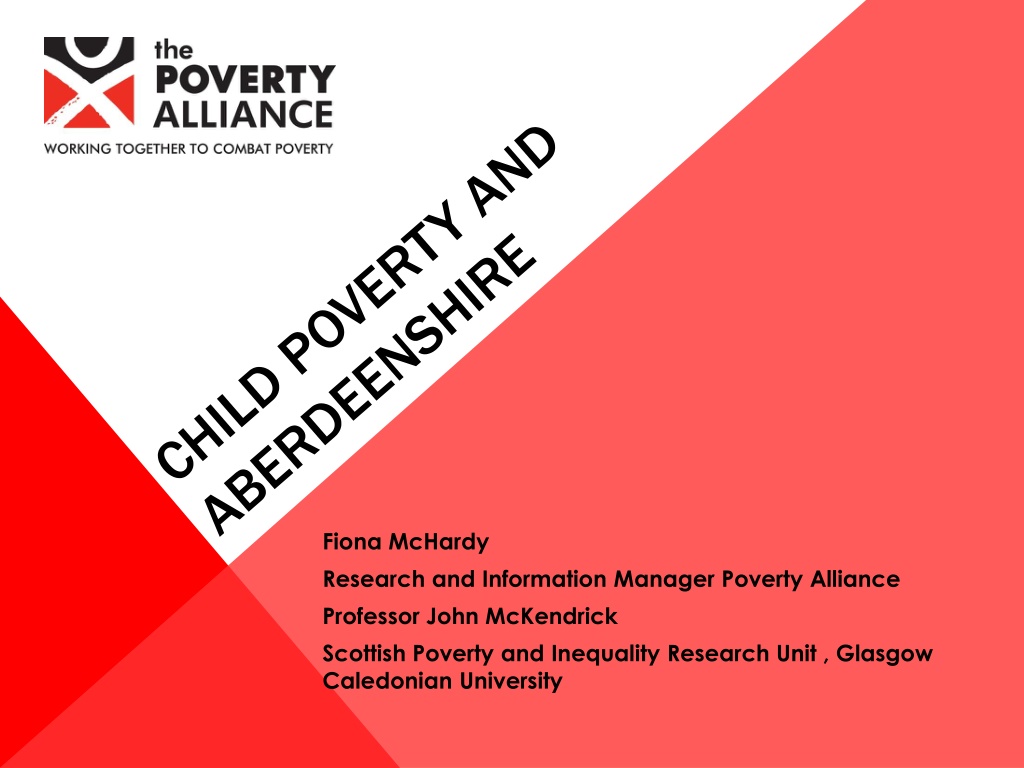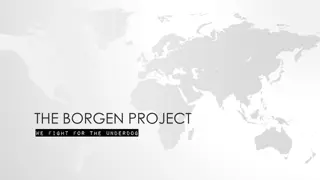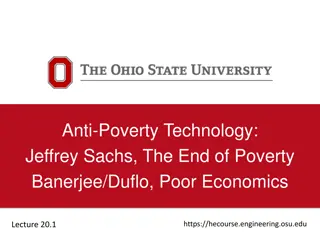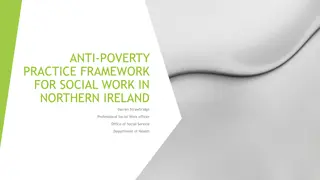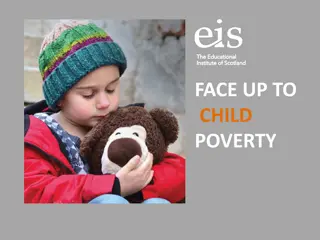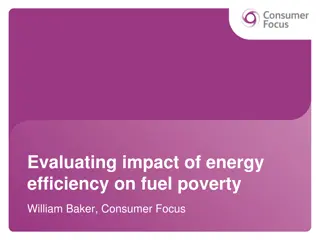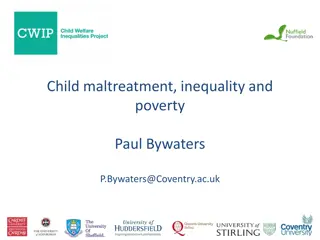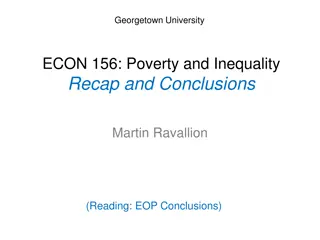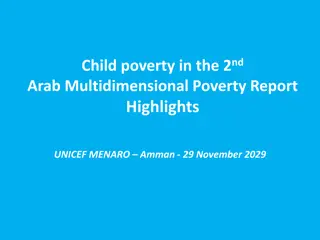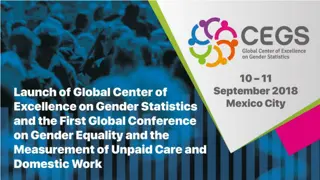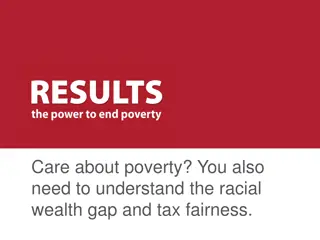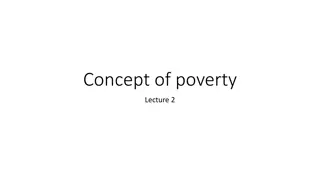Addressing Child Poverty in Aberdeenshire: Research Insights and Recommendations
Research conducted to inform policies and strategies to tackle child poverty in Aberdeenshire, exploring the nature, impact, and factors contributing to poverty within the community. The study delves into the lived experiences of those affected, outlining effective actions and strategies to protect vulnerable families and enhance resilience in different localities.
Download Presentation

Please find below an Image/Link to download the presentation.
The content on the website is provided AS IS for your information and personal use only. It may not be sold, licensed, or shared on other websites without obtaining consent from the author. Download presentation by click this link. If you encounter any issues during the download, it is possible that the publisher has removed the file from their server.
E N D
Presentation Transcript
Fiona McHardy Research and Information Manager Poverty Alliance Professor John McKendrick Scottish Poverty and Inequality Research Unit , Glasgow Caledonian University
OUR ORIGINAL BRIEF Research to inform the design and delivery of both council-specific policy and the Aberdeenshire CPP strategic approach to addressing child poverty in Aberdeenshire. Specifically to better understand the nature of poverty within an Aberdeenshire context, including the short-, medium and long term action required to improve outcomes for children and families at an individual, household and community level.
OUR ORIGINAL BRIEF Explore the nature and impact of poverty and deprivation, including child poverty, across Aberdeenshire, and also the contributory and mitigating factors and their distribution across Aberdeenshire. Explore the place/locality specific factors that provide a challenge to those on low income, living in poverty and at risk if moving into poverty, including the impacts of these factors on their everyday lives and coping strategies. Explore the experience of those in Aberdeenshire living in poverty describe the key settings where effective action could be undertaken by Aberdeenshire Community Planning partners to prevent child poverty and alleviate the adverse impact of poverty in Aberdeenshire, including strategies to maximise incomes.
OUR ORIGINAL BRIEF Drawing on the experience of those in Aberdeenshire living in poverty outline the action required, with a clear locality focus where appropriate, that will be effective in protecting those living in poverty from the worst excesses of living with poverty. Explore strategies that the Aberdeenshire CPP can adopt to enhance the coping strategies and resilience of families and children living in poverty in Aberdeenshire and describe how these could be delivered within different localities across Aberdeenshire.
METHODOLOGY Focus group discussions held with adults and young people using participatory tools used pictorial tools . Benefits in obtaining diversity of opinion and experiences. Included the voice of young people reflecting a household understanding being about more than just parents and caregivers and this is an important consideration for work going forward. Online Telephone interviews conducted to allow us to have a broader spread of views and experiences .
LESSONS FOR ENGAGEMENT Understanding of the value of research. Perceptions of barriers : People won t engage . Terminology and use of language on how we talk about Poverty . Over researched and under researched . Going beyond the traditional working with stakeholders to think about promotion and demographics . Feedback . How will we do this ??
SURVEY DATA 1 OF 4 Service providers think tackling child Service providers think tackling child poverty matters poverty matters Service providers think that there is child Service providers think that there is child poverty in Aberdeenshire poverty in Aberdeenshire
WHOSE RESPONSIBILITY TO TACKLE? Scottish government 92% Aberdeenshire local government 89% UK government 81% Voluntary and community groups 73% Aberdeenshire CPP 72% People living in poverty 69% NHS Grampian 66% Local businesses and employers 60% Friends/relatives of poorest 50% 0% 10% 20% 30% 40% 50% 60% 70% 80% 90% 100%
WHAT SHOULD BE OUR PRIORITY? Prevent future Reduce Ameliorate Prevent now 0.0% 5.0% 10.0% 15.0% 20.0% 25.0% 30.0% 35.0%
WHAT CAUSES CP IN ABERDEENSHIRE? 21% 61% 61% Addictions/abuse 14% 25% 25% Work doesn't pay enough 10% 9% 9% Social benefits 10% 18% 18% Inequalities in society 9% 43% 43% Out of work for a long time 8% 35% 35% Lack education 7% 53% 53% Not want to work 6% 39% 39% Poor quality area 3% 37% 37% Family break-up or loss 3% 19% 19% Generational 2% 40% 40% Illness or disability 2% 35% 35% Too many children 1% 25% 25% Affordable housing 0% 17% 17% Not work enough hours 0% 21% 21% Discrimination 4% Other 0% 10% 20% 30% 40% 50% 60% 70% 80% 90% Main All
ARE WE DIFFERENT? Addictions/abuse Illness or disability Out of work for a long time Family break-up or loss Work doesn't pay enough Affordable housing Inequalities in society Lack education Poor quality area Not want to work Social benefits Discrimination Generational Too many children Not work enough hours Other 0% 10% 20% 30% 40% 50% 60% 70% 80% 90% 100% Scotland A/Shire
QUALITATIVE DATA : PREVENTION Understandings of poverty and how poverty was defined was mixed. Some openly defined themselves as living on a low income but not experiencing poverty. This led to confusion about if there was help available for people in their circumstances. Many also spoke about concepts of who was more deserving in the community. Entitlements and advice was a core challenges for many, people spoke of being confused and unsure of what help was on offer and where they could get advice. Some experiences raised of people having benefit cuts/changes. Similarly there was confusion for those in work and what was available to assist. them.
QUALITATIVE DATA : PREVENTION Digitalisation and technological changes had implications for households, across this study emerged : Cost of digital access for households in their day to day outgoings. Local provision requiring online access such people having to make school payments only through an online system. Some households had limited online access and issue around the conditionality and job searching. Confidence and experience using digital technology.
QUALITATIVE DATA : PREVENTION my cooker broke last December kind of still aim to be able to afford a new one and that s been kind of saving up almost a year noo yoi cannae just go in there and hadn oe er the money , you ve got taw go dae it online, everything got to be online
QUALITATIVE DATA : PREVENTION In work poverty presented a complex mix of issues across this study this included: Being ineligible for other entitlements that they may benefit from within the household due to income thresholds . At risk of further poverty due to changes such in contracted hours, wages rates being low , transport costs , paying full rate for housing etc. Specific locality risk due to transport and seasonal weather and entry level jobs available for young people in particular . Concern for migrant workers residing post Brexit and the potential issues household may face.
QUALITATIVE DATA : PREVENTION the way the council and government - you want to people to work and earn more money but by doing so you get penalised . She's earning basically the minimum wage she is works 24 hours a week but by getting working tax credit we don't get free school meals. The youngest will get she gets them the now and will be going into primary 4 she's gets it up to 3 after that she will need to pay for them come next year I will have to pay for that. Its about 2.00 a day about a tenner a week
QUALITATIVE DATA : ALLEVIATION Generally people spoke of the importance of services being delivered as locally as possible and through to face interactions as opposed to online systems . Interactions needed to be no stigmatising and non judgemental , examples emerged across our study of negative attitudes and how this inhibited or in some cases resulted in people not accessing services. The importance of empathy was critical in terms of how people felt about an engagement .
QUALITATIVE DATA : AMELIORATION/ QUALITY OF LIFE Local facilities/ activities for families and their costs was critical this needed to be considered for both those in and out of work. Hidden costs for families within schools presented pressure on households to find additional costs in their day to day budgets . Centralisation of services had resulted in people travelling further for services , this meant they faced pressure trying to pay for higher costs of travel . Coping strategies huge emphasis across the data on people relying on support networks or withdrawing or going without.
QUALITATIVE DATA : AMELIORATION/ QUALITY OF LIFE we just have a duvet day and a jammie day and watch films because that s what we do because we cant put the heating on all the time . So we just go under the blankets and hae DVD days there used to be lots of job centres in the smaller communities now they are all gone
QUALITATIVE DATA : AMELIORATION/ QUALITY OF LIFE Well basically every penny is accounted for , we find the kids going to school there always seems to be something ie a raffle or something like that or a dress as you please day. There never seems to be money going spare or any money going spare , or broken appliance weekend need to save up for it . Don't have credit cards , aren't able to able to buy anything.
FRAMING TODAYS DISCUSSION Amelioration/ Amelioration/ Quality of Life Quality of Life Prevention Prevention Alleviation Alleviation What more can service providers do in the region to help reduce the number of children falling into poverty? What are the key drivers that can be addressed at the local level? How can partnerships be strengthened to take a preventive approach? What more can be done to make existing services more effective in the mitigation of child poverty? What are the key groups and areas that should be targeted? How can we improve the delivery and accessibility of service to people living on low incomes? How to improve the well- being of people living on low incomes in the short term?
